Selected HIV-1 Env trimeric formulations act as potent immunogens in a rabbit vaccination model
- PMID: 24023951
- PMCID: PMC3759472
- DOI: 10.1371/journal.pone.0074552
Selected HIV-1 Env trimeric formulations act as potent immunogens in a rabbit vaccination model
Abstract
Background: Ten to 30% of HIV-1 infected subjects develop broadly neutralizing antibodies (bNAbs) during chronic infection. We hypothesized that immunizing rabbits with viral envelope glycoproteins (Envs) from these patients may induce bNAbs, when formulated as a trimeric protein and in the presence of an adjuvant.
Methods: Based on in vitro neutralizing activity in serum, patients with bNAbs were selected for cloning of their HIV-1 Env. Seven stable soluble trimeric gp140 proteins were generated from sequences derived from four adults and two children infected with either clade A or B HIV-1. From one of the clade A Envs both the monomeric and trimeric Env were produced for comparison. Rabbits were immunized with soluble gp120 or trimeric gp140 proteins in combination with the adjuvant dimethyl dioctadecyl ammonium/trehalose dibehenate (CAF01). Env binding in rabbit immune serum was determined using ELISAs based on gp120-IIIB protein. Neutralizing activity of IgG purified from rabbit immune sera was measured with the pseudovirus-TZMbl assay and a PBMC-based neutralization assay for selected experiments.
Results: It was initially established that gp140 trimers induce better antibody responses over gp120 monomers and that the adjuvant CAF01 was necessary for such strong responses. Gp140 trimers, based on HIV-1 variants from patients with bNAbs, were able to elicit both gp120IIIB specific IgG and NAbs to Tier 1 viruses of different subtypes. Potency of NAbs closely correlated with titers, and an gp120-binding IgG titer above a threshold of 100,000 was predictive of neutralization capability. Finally, peptide inhibition experiments showed that a large fraction of the neutralizing IgG was directed against the gp120 V3 region.
Conclusions: Our results indicate that the strategy of reverse immunology based on selected Env sequences is promising when immunogens are delivered as stabilized trimers in CAF01 adjuvant and that the rabbit is a valuable model for HIV vaccine studies.
Conflict of interest statement
Figures

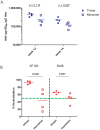
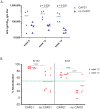
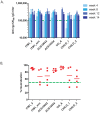
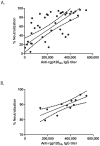

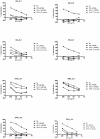
References
-
- Shibata R, Igarashi T, Haigwood N, Buckler-White A, Ogert R, et al. (1999) Neutralizing antibody directed against the HIV-1 envelope glycoprotein can completely block HIV-1/SIV chimeric virus infections of macaque monkeys. Nature medicine 5: 204–210. - PubMed
-
- Mascola JR, Stiegler G, VanCott TC, Katinger H, Carpenter CB, et al. (2000) Protection of macaques against vaginal transmission of a pathogenic HIV-1/SIV chimeric virus by passive infusion of neutralizing antibodies. Nature medicine 6: 207–210. - PubMed
-
- Veazey RS, Shattock RJ, Pope M, Kirijan JC, Jones J, et al. (2003) Prevention of virus transmission to macaque monkeys by a vaginally applied monoclonal antibody to HIV-1 gp120. Nature medicine 9: 343–346. - PubMed
Publication types
MeSH terms
Substances
LinkOut - more resources
Full Text Sources
Other Literature Sources
Medical
Molecular Biology Databases

